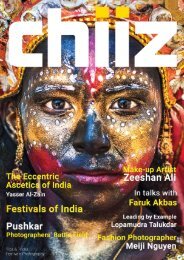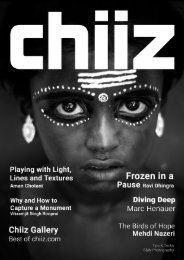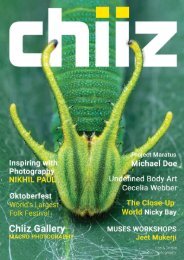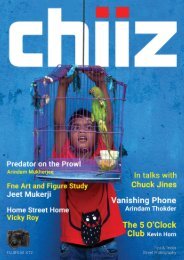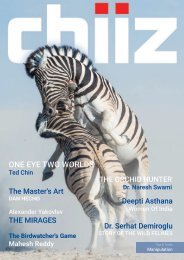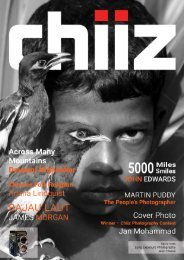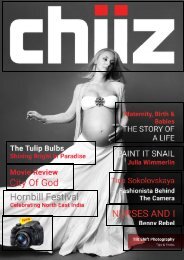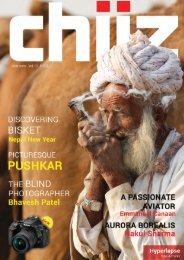Chiiz Volume 7 :Fashion Photography
When people stand in front of the mirror to have a good long look at themselves, they always hope to see a better reflection of themselves than what they have seen previously and with all this, they have grown conscious of how they appear and how comfortable they are with what they wear.Not only their clothes, but also their comfort level, express the sense of style and their conformity to the outer world.In this issue, what we have focussed on might not be the mainstream fashion and people might not get the hype that revolves around the fashion world but what we have here is something that is responsible for all that we have achieved so far in this industry. Be it natural beauty by Lynn Theisen, backstage brilliance by Ishaan Nair, or the street fashion by Rohit Arora which is now gaining popularity among the more prominent photographers.The interview with John Rawson is an eye opener. He is has been through it all andhis experiences form a great lesson for all of us. The series of Roshini Kumar with Suhail Nayyar is also a masterpiece in itself which is a true symbol of comfortable fashion statements. Rod Klein and Jorge Gonzalez’s underwater fashion photographs present an altogether different approach to see things.
When people stand in front of the mirror to have a good long look at themselves, they always hope to see a better reflection of themselves than what they have seen previously and with all this, they have grown conscious of how they appear and how comfortable they are with what they wear.Not only their clothes, but also their comfort level, express the sense of style and their conformity to the outer world.In this issue, what we have focussed on might not be the mainstream fashion and people might not get the hype that revolves around the fashion world but what we have here is something that is responsible for all that we have achieved so far in this industry. Be it natural beauty by Lynn Theisen, backstage brilliance by Ishaan Nair, or the street fashion by Rohit Arora which is now gaining popularity among the more prominent photographers.The interview with John Rawson is an eye opener. He is has been through it all andhis experiences form a great lesson for all of us. The series of Roshini Kumar with Suhail Nayyar is also a masterpiece in itself which is a true symbol of comfortable fashion statements. Rod Klein and Jorge Gonzalez’s underwater fashion photographs present an altogether different approach to see things.
Create successful ePaper yourself
Turn your PDF publications into a flip-book with our unique Google optimized e-Paper software.
Dwindling Lives<br />
NIKON D610 50mm F/8 1/250s ISO200<br />
Nicotine Soaked Lives : A Glance into<br />
The Tobacco Farming Industry in Turkey<br />
Meriç Aktar<br />
@mericaktar is a 32 years old hobbyist<br />
photographer who lives in Samandag,<br />
Hatay, Turkey. He began chasing light<br />
and capturing moments in 2012, since<br />
then, picking up the camera gave him<br />
an opportunity to capture a specific<br />
vision to share with others. Ultimately,<br />
a well captured image represents a<br />
moment in time that is expressed<br />
infinitely, and that’s enough of a reason<br />
for him to hang the camera around his<br />
shoulders every time he steps out of<br />
his home. As such, with a greater<br />
appreciation of the documenting<br />
people via photography, he has also<br />
developed a greater connection with<br />
people and life.<br />
For most of us the word “Tobacco” triggers<br />
one of these two probable reactions, a) A<br />
strong abhorrence (generally associated with<br />
the detrimental effect it has on our health).<br />
Or b) An even stronger urge, fuelled by years<br />
of addiction and/or decades worth of popular<br />
culture, to light the nearest cigarette. If it’s not<br />
one of these two things, it’s probably some<br />
botanical inquiry into the structure of the<br />
plant itself.<br />
Yes, Tobacco is all of those things and more.<br />
But for about a few hundred families living<br />
in Yayladagi, in the Hatay province of Turkey,<br />
tobacco isn’t death or grave addictions; it is<br />
life. Tobacco, for them, is neither some means<br />
to placate an oral fixation, nor is it the tiny font<br />
and the skull and crossbones that warn against<br />
its consumption. These tobacco farmers are<br />
in no way associated with the ongoing power<br />
struggles between “Big Tobacco” and the<br />
organizations against it, when quite ironically,<br />
they are intrinsic to the production of the very<br />
“thing” governments, business conglomerates,<br />
and activists tussle over. Tobacco for them is<br />
what puts bread on the table; what sends their<br />
kids to school ; and what puts them on the<br />
map.<br />
For the uninitiated, which is quite frankly<br />
most of us, here is a brief history of Turkish<br />
tobacco. Tobacco, of course, originated in the<br />
Americas. It was introduced to the Ottoman<br />
Empire (modern day Turkey, Republic of<br />
Macedonia, Bulgaria and Greece) by Spanish<br />
traders. The Ottoman Turks devised their own<br />
way of cultivating, harvesting, curing, and<br />
later, using the tobacco - and thus a distinctly<br />
“Turkish” variety came into being. Turkish<br />
tobacco dominated the global markets for<br />
most of the 20th century. It peaked during<br />
the 1960s when the Turkish kind was the<br />
most sought-after variety. Turkish tobacco<br />
is highly aromatic and being specifically<br />
“sun-cured” adds to the flavour. Ideally, this<br />
type of tobacco is used exclusively for pipes<br />
and cigarette manufacturing. In fact, most<br />
of the early brands of cigarettes only made<br />
80 Vol 7



